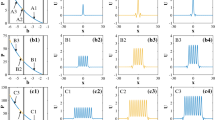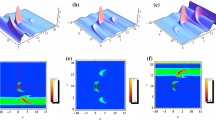Abstract
Solitons are paradigm localized states in physics. We consider here gapacoustic solitons (GASs), which are stable pulses that exist in Bragg waveguides, and which offer promising new avenues for slowing light. A Bragg grating can be produced by doping the waveguide with ions, and imprinting a periodic variation in the index of refraction with ultraviolet light. The Bragg grating in an optical waveguide reflects rightward-moving light to the left, and vice versa, and creates a gap in the allowed frequency spectrum of light. Nonlinearities, though, add complications to this simple picture. While low intensity light cannot propagate at frequencies inside the band gap, more intense fields can exist where low-intensity fields cannot. An optical gap soliton is an intense optical pulse which can exist in a Bragg waveguide because the intensity and nonlinearity let it dig a hole for itself inside the band gap, in which it can then reside. Far from the center of the pulse, the intensity is weak, and drops off exponentially with distance from the center. The optical gap soliton structure can be stable, and can have velocities from zero (i.e., stopped light) up to the group-velocity of light in the medium. When one also considers the system’s electrostrictive effects, i.e., the dependence of the index of refraction on the density of the material, which is a universal light-sound interaction in condensed matter, one obtains GASs. These solitons share many of the properties of standard gap solitons, but they show many fascinating new characteristics. GASs have especially interesting dynamics when their velocities are close to the speed of sound, in which range they interact strongly with the acoustic field. GASs which are moving at supersonic velocities may experience instabilities which leave the GAS whole, but bring the velocity abruptly to almost zero. Furthermore, GASs may be made to change velocity by collision with acoustic pulses. Moving GASs may be retarded by the phonon viscosity, as well as by interaction with high wave number (Brillouin) acoustic waves. Thus, the opto-acoustic interactions provide the basis for a set of tools with which light in the form of a GAS can be slowed down and controlled. In contrast with other forms of slow or stopped light, GASs can exist at room temperature, in relatively unexotic materials. This makes the GAS an attractive form in which to create and work with slow and stopped light.
Access this chapter
Tax calculation will be finalised at checkout
Purchases are for personal use only
Preview
Unable to display preview. Download preview PDF.
Similar content being viewed by others
Author information
Authors and Affiliations
Corresponding author
Editor information
Editors and Affiliations
Rights and permissions
Copyright information
© 2011 Springer-Verlag Berlin Heidelberg
About this chapter
Cite this chapter
Tasgal, R.S., Shnaiderman, R., Band, Y.B. (2011). Gap-Acoustic Solitons: Slowing and Stopping of Light. In: Descalzi, O., Clerc, M., Residori, S., Assanto, G. (eds) Localized States in Physics: Solitons and Patterns. Springer, Berlin, Heidelberg. https://doi.org/10.1007/978-3-642-16549-8_3
Download citation
DOI: https://doi.org/10.1007/978-3-642-16549-8_3
Published:
Publisher Name: Springer, Berlin, Heidelberg
Print ISBN: 978-3-642-16548-1
Online ISBN: 978-3-642-16549-8
eBook Packages: Physics and AstronomyPhysics and Astronomy (R0)




